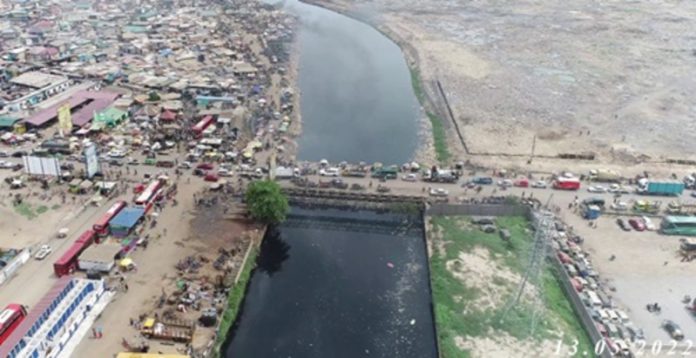
Several bridges and structures across the Odaw channel have been earmarked for reconstruction or removal to allow for the free flow of rainwater to prevent perennial flooding in the capital.
The identified bridges – the Railroad bridge at Odawna, Graphic Road bridge, Abossey Okai bridge, near the Central Mosque, Agbogbloshie bridge and the Dome Pillar Two bridge – are plagued with engineering defects that make them obstruct the free flow of rainwater into the Odaw drain.
They are to be reconstructed as part of the $200 million World Bank-funded GARID project which was rolled out to address the perennial flooding in Accra. In addition, two small bridges at the Kwame Nkrumah Circle have also been proposed for removal from the Odaw drain.
The Coordinator of the Greater Accra Resilient and Integrated Development (GARID) project, Dr Kwadwo Ohene Sarfoh, said the bridges were identified in a Flood Hazard and Risk Assessment conducted in 2019 to determine the causes of perennial flooding in Accra.
“There are bridges that have been constructed such that they fall within the basin depth; so when the water levels are rising within the basin, the bridges rather become obstructions at some point,” he explained.
In the aftermath of the flood disaster that claimed about 200 lives in Accra on June 3, 2015, the Greater Accra Climate Risk Mitigation Strategy was put together in 2019, seeking to improve drainage and make the city resilient to flooding.
Subsequently, the $200 million GARID project was rolled out to address the obstacles to perennial flooding by investing in the Odaw basin to hold back the volume of flow and increase the efficiency of the drainage infrastructure.
Report
The Flood Hazard and Risk Assessment that was conducted as part of the Accra Climate Risk Mitigation Strategy revealed that some bridges constructed over sections of the Odaw drain were overtopped by floods or blocked the flow of water which piled-up debris.
The report recommended that bridges within the channel which obstructed the flow of water should be raised, removed or widened to eliminate the backwater effect.
Dr Sarfoh stressed that those bridges were not helpful to the free flow of water and contributed significantly to the perennial flooding in Accra.
Tributaries expansion
He said tributaries of the Odaw drain, including the Nima drain, were narrow and needed to be widened or reconstructed. For instance, he said the Nima drain, which ran from the Opeibea area at the Airport and meanders its way through Nima, Asylum Down, Kwame Nkrumah Circle, into the Odaw drain was too small to carry the volumes of runoff water that was conveyed into the Odaw channel when it rained.
“At the terminal point, it enters the Odaw at 90 degrees – that is how it was constructed. Because of the way it was constructed, it always has a backwater effect,” he said. Dr Sarfoh added that as part of the GARID project, the drains were being widened to enhance the flow of water into the main Odaw drain.
He said they were also changing the angle at which the Nima drain entered the main Odaw drain to ensure ease of flow and more capacity to take runoff water. The GARID coordinator added that a similar intervention was being considered for the Kaneshie tributary.
Siltation
Dr Sarfoh added that apart from the removal of materials that obstructed the flow of water, the GARID project had also rolled out a programme to routinely evacuate silted drains in the Odaw basin.
“For some time now, there has not been a programmed approach to consistently dredge the river. We are doing that under the GARID through the performance-based contractual approach to dredging,” he said.
He explained that under the performance-based dredging contracts, contractors would be paid based on the performance of the drain rather than the volume of waste extracted from the drains.
The GARID coordinator added that the project was seeking technical assistance from the Netherlands to support in implementing the new dredging regime. “There is an ongoing conversation for strengthening the capacity of the Ghana Hydrological Authority (GHA) to be able to deliver on the new dredging regime.
“Once we get it right, it can be extended to all drainage projects to ensure that the contractor is not just focused on extracting sand or sediments but also ensuring the proper functioning of the drain,” he said.
He added that the new dredging arrangement provided an incentive for the contractor to recover sand that could be reused.
ALSO READ:

